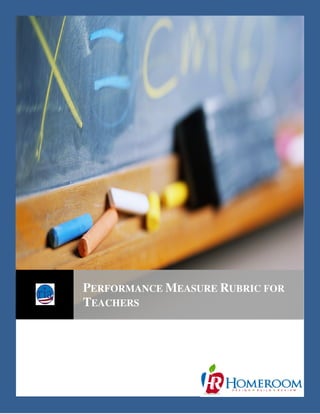Weitere ähnliche Inhalte
Ähnlich wie Performance measure rubric
Ähnlich wie Performance measure rubric (20)
Mehr von Research in Action, Inc.
Mehr von Research in Action, Inc. (20)
Kürzlich hochgeladen
Industrial Policy - 1948, 1956, 1973, 1977, 1980, 1991Industrial Policy - 1948, 1956, 1973, 1977, 1980, 1991RKavithamani
Kürzlich hochgeladen (20)
Performance measure rubric
- 2. Assessment Rubric for Teachers©
Page 2
General Purpose
The enclosed rubric is designed to examine the quality characteristics of teacher-made
performance measures. The rubric is comprised of 18 technical aspects organized into three (3)
strands. The rubric’s purpose is to provide teachers with a self-assessment tool that assists in
building “great” measures of student achievement.
Rating Tasks
Step 1. Review information, data, and documents associated with the design,
development, and review of the selected performance measure.
Step 2. Assign a value in the “Rating” column for each aspect within a particular strand
using the following scale:
a. (1) = fully addressed
b. (.5) = partially addressed
c. (0) = not addressed
d. (N/A) = not applicable at this time
Step 3. Reference supporting information associated with each assigned rating in the
“Evidence” column.
Step 4. Add any additional notations and/or comments that articulate any important
nuances of the performance measure.
Step 5. Compile assigned values and place in the “Strand Summary” row.
Summary Matrix
Strand
Points
Possible
Points
Earned
Design 5
Build 6
Review 7
Summary 18
- 3. Assessment Rubric for Teachers©
Page 3
STRAND 1: DESIGN
Task
ID
Descriptor Rating Evidence
1.1
The purpose of the performance measure is explicitly
stated (who, what, why).
1.2
The performance measure has targeted content
standards representing a range of knowledge and skills
students are expected to know and demonstrate.
1.3
The performance measure’s design is appropriate for
the intended audience and reflects challenging
material needed to develop higher-order thinking
skills.
1.4
Specification tables articulate the number of
items/tasks, item/task types, passage readability, and
other information about the performance measure -
OR- Blueprints are used to align items/tasks to
targeted content standards.
1.5
Items/tasks are rigorous (designed to measure a range
of cognitive demands/higher order thinking skills at
developmentally appropriate levels) and of sufficient
quantities to measure the depth and breadth of the
targeted content standards.
Strand 1 Summary
___out of
5
Additional Comments/Notes
- 4. Assessment Rubric for Teachers©
Page 4
STRAND 2: BUILD
Task
ID
Descriptor Rating Evidence
2.1
Items/tasks and score keys are developed using
standardized procedures, including scoring rubrics for
human-scored, open-ended questions (e.g., short
constructed response, writing prompts, performance
tasks, etc.).
2.2
Item/tasks are created and reviewed in terms of: (a)
alignment to the targeted content standards, (b)
content accuracy, (c) developmental appropriateness,
(d) cognitive demand, and (e) bias, sensitivity, and
fairness.
2.3
Administrative guidelines are developed that contain
the step-by-step procedures used to administer the
performance measure in a consistent manner,
including scripts to orally communicate directions to
students, day and time constraints, and allowable
accommodations/adaptations.
2.4
Scoring guidelines are developed for human-scored
items/tasks to promote score consistency across
items/tasks and among different scorers. These
guidelines articulate point values for each item/task
used to combine results into an overall score.
2.5
Summary scores are reported using both raw score points
and performance level. Performance levels reflect the
range of scores possible on the assessment and use terms
or symbols to denote performance levels.
2.6
The total time to administer the performance measure is
developmentally appropriate for the test-taker. Generally,
this is 30 minutes or less for young students and up to 60
minutes per session for older students (high school).
Strand 2 Summary
___out of
6
Additional Comments/Notes
- 5. Assessment Rubric for Teachers©
Page 5
STRAND 3: REVIEW
Task
ID
Descriptor Rating Evidence
3.1
The performance measures are reviewed in terms of
design fidelity-
• Items/tasks are distributed based upon the design
properties found within the specification or
blueprint documents.
• Item/task and form statistics are used to examine
levels of difficulty, complexity, distracter
quality, and other properties.
• Items/tasks and forms are rigorous and free of
bias, sensitive, or unfair characteristics.
3.2
The performance measures are reviewed in terms of
editorial soundness, while ensuring consistency and
accuracy of other documents (e.g., administration)-
• Identifies words, text, reading passages, and/or
graphics that require copyright permission or
acknowledgements
• Applies Universal Design principles
• Ensures linguistic demands and/or readability is
developmentally appropriate
3.3
The performance measures are reviewed in terms of
alignment characteristics-
• Pattern consistency (within specifications
and/or blueprints)
• Matching the targeted content standards
• Cognitive demand
• Developmental appropriateness
3.4
Cut scores are established for each performance level.
Performance level descriptors describe the
achievement continuum using content-based
competencies for each assessed content area.
3.5
As part of the assessment cycle, post administration
analyses are conducted to examine such aspects as
items/tasks performance, scale functioning, overall
score distribution, rater drift, content alignment, etc.
- 6. Assessment Rubric for Teachers©
Page 6
Task
ID
Descriptor Rating Evidence
3.6
The performance measure has score validity evidence
that demonstrated item responses were consistent with
content specifications. Data suggest the scores
represent the intended construct by using an adequate
sample of items/tasks within the targeted content
standards. Other sources of validity evidence such as
the interrelationship of items/tasks and alignment
characteristics of the performance measure are
collected.
3.7
Reliability coefficients are reported for the
performance measure, which includes estimating
internal consistency. Standard errors are reported for
summary scores. When applicable, other reliability
statistics such as classification accuracy, rater
reliabilities, and others are calculated and reviewed.
Strand 3 Summary
___out of
7
Additional Comments/Notes

